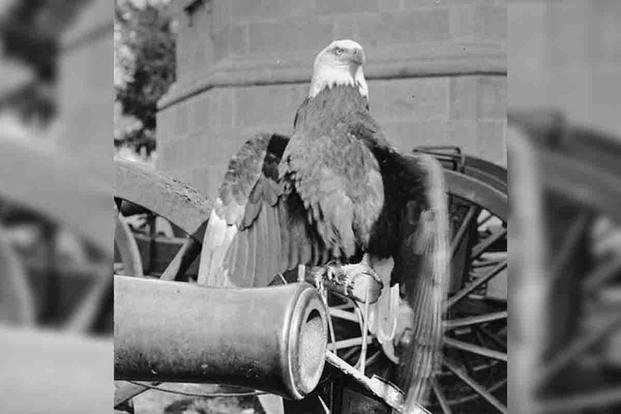The 101st Airborne Division has probably one of the most recognizable insignias in the U.S. military. Aside from its participation in some of the most famed battles of the 20th century, the 101st's "Screaming Eagle" patch was made famous even among civilians by the true-to-life HBO television series "Band of Brothers."
That screaming eagle's name is "Old Abe," based on the life of a real bald eagle who served with Wisconsin volunteers during the Civil War and has a long history with the state of Wisconsin. The 101st Airborne just happened to be in the right place at the right time to get Old Abe on its insignia.
In 1861, before the outbreak of the Civil War, a member of the Ojibwe tribe captured a young eaglet. Since it was just a few months old, he kept it as a pet. How he caught it is still debated, but historians know it was traded to the McCanns, a family of Wisconsin settlers. When the war started, the father of the family sold it to a band of recruits from Eau Claire.
Capt. John E. Perkins, the company commander, named him "Old Abe" after President Lincoln, commissioned a special "union shield" perch for the bird and assigned one of his troops to look after him. Old Abe became the official mascot of Company C, 8th Wisconsin Volunteer Infantry Regiment -- nicknamed the "Eagles."
By 1862, the Wisconsin volunteers were in the thick of the fighting in the war's Western Theater. For the whole of their three-year enlistment, Old Abe went into combat with the men of the 8th across Missouri, Mississippi and Louisiana, from Vicksburg to the Red River. Though he had some close calls, Wisconsin's beloved war eagle came out of the war relatively unscathed.

The Civil War ended long after Old Abe and the 8th Wisconsin returned home. The volunteers presented him to the State of Wisconsin, which created a special apartment for Old Abe inside the state Capitol building. His fame wasn't limited to Wisconsin, however. His presence was requested at Civil War veterans reunions, Grand Army of the Republic (a Civil War veterans service organization) events and even the 1876 Centennial Exposition in Philadelphia.
Old Abe served for Wisconsin once again in February 1881, when a fire broke out in the Capitol. It was their beloved eagle that raised the alarm, letting fire brigades know there was a problem in the building. Unfortunately, Abe inhaled a lot of smoke in the fire and died a month later. Veterans from across the state volunteered to serve as pallbearers at his funeral.
Instead of burying their mascot, the governor had him stuffed and perched in a permanent spot inside the Capitol rotunda in Madison. His remains were moved to a few locations between 1885 and 1903, but he eventually found his way back to his original perch. The Capitol unfortunately caught fire once again in 1904, destroying Old Abe and his glass case.
Today, a stone Old Abe is perched on what used to be the archway entrance to Camp Randall, where the 8th Wisconsin first formed. It's now part of the University of Wisconsin. A replica of Old Abe has overlooked the Wisconsin State Assembly since 1915.
As for the 101st Airborne, it was originally organized in November 1918, much too late to join World War I. It was reformed in 1921 as part of the Army Reserve, with its headquarters in Milwaukee. In a nod to the state's military history, the Army put Old Abe on the unit's insignia.
-- Blake Stilwell can be reached at blake.stilwell@military.com. He can also be found on Twitter @blakestilwell or on LinkedIn.
Want to Learn More About Military Life?
Whether you're thinking of joining the military, looking for post-military careers or keeping up with military life and benefits, Military.com has you covered. Subscribe to Military.com to have military news, updates and resources delivered directly to your inbox.
















